WATCH: Andy Murray will retire from tennis due to injury
Tennis Magazine Archives: Andy Murray is a rebel in reverse
By Steve Tignor Jan 11, 2019ATP Munich, Germany
Ben Shelton: European football's newest superfan? Lefty making most of Munich debut
By Emma Storey Apr 15, 2025ATP Barcelona, Spain
Casper Ruud, Stefanos Tsitsipas open Barcelona bids in quest to halt further ranking slides
By TENNIS.com Apr 15, 2025Tennis.com Interview
Jan-Lennard Struff sees Munich title defense bid as 'perfect opportunity' to turn 2025 around
By Emma Storey Apr 14, 2025Stat of the Day
Andrey Rublev storms to 100th ATP 500 win of career with opening victory in Barcelona
By John Berkok Apr 14, 2025ATP Monte Carlo, Monaco
Monte Carlo takeaways: Alcaraz wins by playing for himself, one-handed backhands hold firm
By Joel Drucker Apr 14, 2025Lifestyle
Alexandra Eala: The reality of travel and difficulty of securing visas with a Philippine passport
By Baseline Staff Apr 14, 2025Week In Preview
Aryna Sabalenka takes her first crack at Iga Swiatek's clay-court supremacy in Stuttgart
By Steve Tignor Apr 14, 2025ATP Challenger Tour
ATP Challenger Tour: History made for Felipe Meligeni Alves
By Florian Heer Apr 14, 2025The Business of Tennis
Carlos Alcaraz surpasses 40 million dollars in career prize money after winning Monte Carlo
By John Berkok Apr 14, 2025Tennis Magazine Archives: Andy Murray is a rebel in reverse
Murray isn't the best player of his era, but he may be remembered
Published Jan 11, 2019
Advertising
Tennis Magazine Archives: Andy Murray is a rebel in reverse
On the news of Andy Murray's impending retirement, we're rerunning a 2016 TENNIS Magazine cover story Steve Tignor wrote about the Scot. The theme then was that Murray, who has emerged as the ATP's most progressive voice in recent years, may eventually been seen as the most important player of his generation. As far as his on-court legacy, the article finished with a guess that, at 29, he wasn't done winning major titles yet, and that his best years might still be ahead of him. While those are behind him now, we do know that he was the best male player of 2016.
*
As he sat down to begin his first press conference at the Miami Open this spring, Andy Murray made for an unlikely-looking radical. Dressed in a blue Under Armour fleece and black sweatpants, with his uncombed hair pushed hastily to one side after a workout, Murray leaned back, put his hands in his pockets and calmly began answering questions. If you knew the world’s No. 2-ranked player only from the steady stream of rants, raves and semi-intelligible soliloquies that flow from his mouth when he’s on court, you might have had trouble recognizing the soft-spoken, levelheaded, 29-year-old new father who sat before the media.
On this day, though, reporters suspected that Murray, despite his easygoing demeanor, was going to have a juicy quote or two for them. They swarmed his table and pushed their cameras, microphones, notepads and whatever recording device they could find into his face.
Two days earlier, Raymond Moore, who was then the chairman of the BNP Paribas Open in Indian Wells, had dialed the tennis world’s outrage meter up to 11—and talked himself out of a job—by stating that the WTA rides on the “coattails” of the ATP, and that, “If I were a lady player, I would go down on my knees every night and thank God that Roger Federer and Rafael Nadal were born, because they have carried this sport.”
Later that day, Novak Djokovic dug the men’s hole a little deeper when he said that ATP players deserve more prize money than WTA players, and expressed his admiration for female pros this way: “They have to go through a lot of things we don’t have to go through. You know, the hormones and different stuff.”
It wasn’t hard to imagine that, behind closed doors, Djokovic’s opinions, if not Moore’s, were shared by some of Murray’s colleagues. Over time, the Grand Slams offered equal pay, but it had never been fully accepted by the men. In recent years, members of the ATP Player Council have talked about trying to make prize money un-equal again.
Advertising
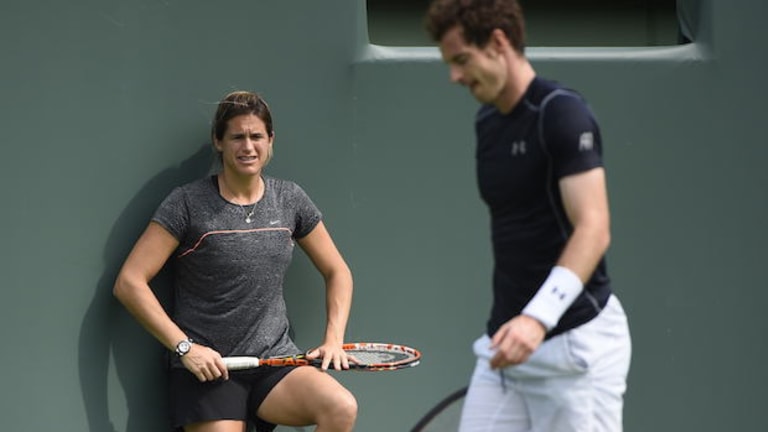
Tennis Magazine Archives: Andy Murray is a rebel in reverse
© Dubreuil Corinne/Sipa USA
But Murray was different. He was the only top men’s player who had hired a woman, Amelie Mauresmo, to be his coach, and he was one of the few who deigned to admit that he enjoyed watching women’s tennis. Murray may also be the only male athlete in any sport, ever, to say the following:
“Have I become a feminist?” he asked in a blog post for French newspaper L’Equipe last June. “Well, if being a feminist is about fighting so that a woman is treated like a man, then yes, I suppose I have.”
If the media was looking for Murray to start a fight in Miami, he didn’t disappoint. He openly questioned Djokovic’s logic before taking the opportunity, as any good progressive would, to nudge his tradition-bound sport a little farther into the future. “I think there should be equal pay, 100 percent, at all combined events,” Murray said.
Currently, dual-gender tournaments in Rome, Canada and Cincinnati offer more prize money to the men, but there has never been a public push to change that, the way there was at the majors. Yet Murray is confident in the rightness of his cause. “I think it will happen one day,” he said.
Just as startling was what Murray said next:
“Men’s tennis has been lucky over the last nine or 10 years, with the players, the rivalries which have come out of that. That’s great, but the whole of tennis should capitalize on that—not just the men’s game.”
The idea that superstars like Federer, Nadal and Djokovic should be working to help not just the men’s game, but the men’s and women’s games, really is something new under the tennis sun. For more than 40 years, since the ATP and WTA were formed in 1972, the tours have run on separate tracks. The chauvinistic schism is built right into the names of their organizations: the Women’s Tennis Association was created in part because, as Billie Jean King put it, “the so-called Association of Tennis Professionals wouldn’t admit female tennis professionals.”
In 2009, WTA commissioner Larry Scott proposed merging the tours and combining their star power, but the men were happy to continue going it alone. Now, finally, they have a player in Murray who is willing to cross the game’s invisible net. At a time when the U.S. women’s soccer team and UFC fighter Ronda Rousey have lifted the profile of female athletes in the United States, and women’s sports look poised to grow, Murray seems less like a wild-eyed revolutionary and more like the right man for the moment.
Advertising
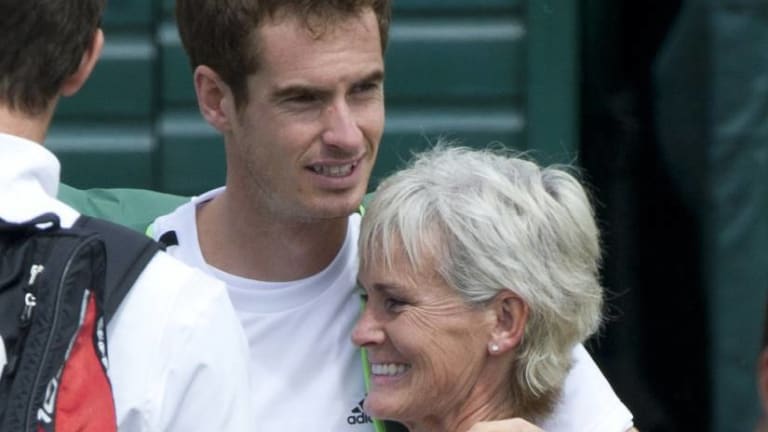
Tennis Magazine Archives: Andy Murray is a rebel in reverse
© AP
How did this lifelong boxing fanatic, who once talked about his willingness to drill his opponents with the ball from point-blank range, become tennis’ most sensitive son? Murray’s first coach was his mother, Judy, but his sympathy for women’s causes grew from the “prejudice” that he watched Mauresmo endure in the early days of their partnership. When Murray struggled after hiring her in 2014, former British champions Virginia Wade and Tim Henman were among those who questioned his choice.
“The staggering thing was that she was [criticized] every time I lost,” Murray told L’Equipe, “which is something my former coaches never, ever experienced. It wasn’t right...Her competence was under fire. I felt embarrassed.”
When Murray reached his first major final with Mauresmo, at the 2015 Australian Open, he was vindicated.
“A lot of people criticized me working with her,” Murray said. “And I think so far this week we have shown that women can be very good coaches as well.”
By the middle of 2016, Murray and Mauresmo’s partnership, historic as it was, had run its course. They parted ways a day after Murray lost to Djokovic in the Madrid final. The moment was symbolic: While Mauresmo had guided Murray to his highest career ranking, No. 2, made him a more consistent competitor and improved his play on clay, she couldn’t push him up to the top rung of the ladder. Murray and Mauresmo didn’t win a Grand Slam title in their two years together, and his loss in Madrid was his 12th in his last 13 meetings with Djokovic.
The Murray-Mauresmo team broke a barrier and made a point, but in the eyes of the sport and the ever-ravenous British media, it still left him with more to prove. Would Murray want it any other way?
“To suggest that he likes proving people wrong,” English sportswriter Simon Barnes once wrote of Murray, “is to suggest that Richard Burton liked a drink.”
*
While Murray’s recent feminist turn is sincere, it’s also typical of an athlete who has always been driven to show the bashers and naysayers—there’s no shortage of either in his country—the errors of their ways, and to take his own road to success, even if it appears to be a long one. This is a man who, at the tender age of 21, released an autobiography with the not-so-tender title Hitting Back. On court and off, Murray’s instinct is to counter-punch.
It’s a trait he seems to have inherited from his mother. In 2003, frustrated by the lack of resources for tennis in the U.K., Judy Murray took out a £30,000 loan to send her youngest son to train on red clay near Barcelona, Spain.
“It was a big risk,” she told The Guardian. “I didn’t realize what we were getting into, but I knew this was the next step he had to take.”
This wasn’t something that had been done often in the tennis no man’s land of Scotland. But it was prescient. On clay, Murray learned the patient, thoughtful game that has served him well in an era when all surfaces have slowed. Murray’s methodical approach has also served his country well. When it comes to British tennis, he has been a one-man oasis after a century of wandering in the desert.
Advertising
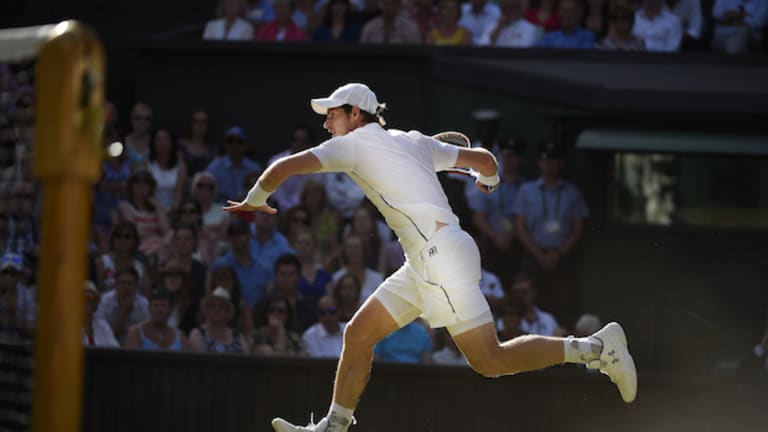
Tennis Magazine Archives: Andy Murray is a rebel in reverse
© Dubreuil Corinne/Sipa USA
In 2012, Murray became the first British man since 1908 to win an Olympic gold medal, and, with his victory at the US Open, the first to win a Grand Slam singles title in 76 years. In 2013, on his ninth try, he became the first British man since Fred Perry to win Wimbledon, ending a 77-year drought. Last November he went 11–0 in Davis Cup competition to lead Great Britain to its first title in the team tournament since 1936.
In all of those cases, Murray accomplished something that many fans in his nation had given up hope of ever seeing. And he did it by ignoring his self-appointed advisers, the columnists and ex-champs who told him he needed to be more aggressive; to leave his beloved baseline and come to the net; to stop whining and moaning and barking profane gibberish; to distance himself from his mother—to become, in other words, someone else.
“I think I persevered,” Murray said of his 2013 Wimbledon triumph. “That’s really been it, the story of my career, probably. I had a lot of tough losses, but the one thing I would say is I think every year I always improved a little bit. They weren’t major improvements, massive changes, but every year my ranking was going in the right direction.”
If anything, Murray’s taste for bucking the boys’ club conventions of pro sports has only grown since. In 2014, he replaced Ivan Lendl, the coach who had helped him earn his biggest wins, with Mauresmo. The laid-back Frenchwoman was different from the stone-cold Czech-turned-American in every regard. After the early criticism, though, and as Murray’s ranking rose, she was grudgingly accepted.
But that spring, Murray found himself defending his relationship with another woman: his wife, Kim Sears. After their April wedding, there were questions about how married life would affect his focus. Murray answered them by winning the first two clay-court titles of his career, in Munich and Madrid. In Madrid, he walked off court and scrawled “MARRIAGE WORKS” on a camera lens.
This February, Sears gave birth to their first child, Sophia. When Murray struggled in his return, speculation swirled that fatherhood was proving to be a distraction. Again, Murray wasted no time in shooting down that argument. It sounded like heresy from a pro athlete, but he said his family came first.
“I’d rather be getting up in the middle of the night and helping my daughter],” he [told the Daily Mail, “than winning every tennis match and her thinking when she grows up, ‘Actually, you know what, he was a s----ty dad, but he won a lot of tennis matches.’”
Advertising
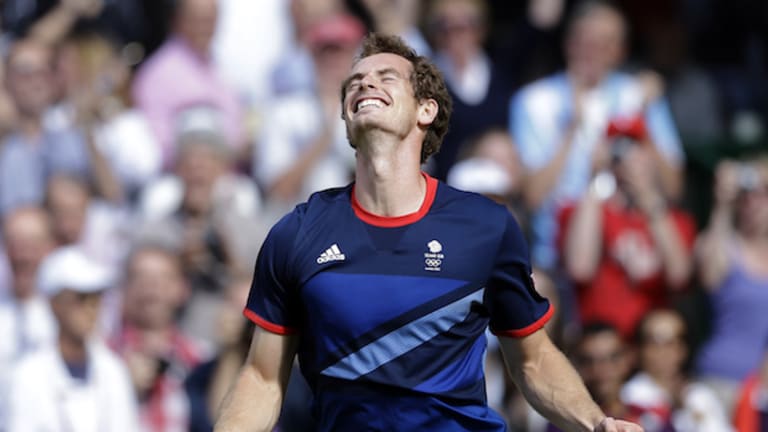
Tennis Magazine Archives: Andy Murray is a rebel in reverse
© AP
By the time this year’s clay swing rolled around, Murray seemed to be relishing his role as a rogue force on tour. In an interview with The Mail on Sunday, he ignored the traditional code of silence among athletes about doping and went public with his suspicions.
“I have played against players and thought, ‘They won’t go away,’ or ‘They don’t seem to be getting tired,’” Murray said. “Have I ever been suspicious of someone? Yeah, you hear things.”
Murray vowed to continue speaking his mind on the subject. And why shouldn’t he? In this era, the top male players have been the most effective forces for change, whether it’s demanding more prize money or prodding the US Open to get rid of Super Saturday and build a roof over Arthur Ashe Stadium. Murray has been integral to those discussions; if he can get the same authorities to do more about doping, and increase fans’ trust that the sport is clean, he really will have pulled off something radical.
*
For all of Murray’s progress off the court, though, his recent on-court performances haven’t been enough to keep the bashers at bay.
Three years after his dizzying Wimbledon peak, and the back surgery that brought him back to earth, Murray is as steady as ever. In 2015, he went 70–6 against everyone except Djokovic or Federer; the trouble is, he went 1–8 against those two. As well as he played with Mauresmo on a week-to-week basis, he didn’t scale the same heights that he did with Lendl. Instead, Murray has had to watch as his old rival, Djokovic, has used his methods to pass him by.
At the start of 2014, Djokovic hired his own super-coach in Boris Becker. He wanted an ex-champion to do for him what Lendl had done for Murray: Get him over the hump in major finals. Since then, Djokovic has won six Grand Slam titles while Murray has remained at two. According to Djokovic, the difference has to do with endurance, both physical and psychological.
Advertising
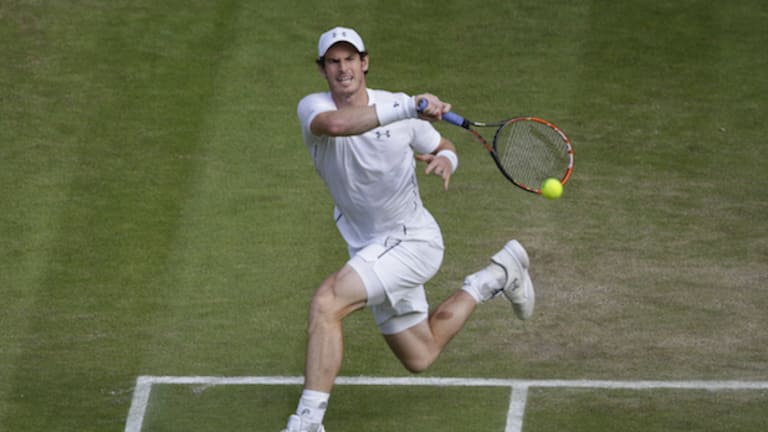
Tennis Magazine Archives: Andy Murray is a rebel in reverse
© AP
“I get the feeling,” Djokovic said when asked about his matches with Murray, “that if I get to stay with him and kind of work, work, work, not get too loose and too frustrated and not allow him to get into a big lead, I feel like there is a point where I feel that I have the edge, maybe physically.”
Does Murray need a figure like Lendl in his camp, a player whose accomplishments were greater than his own and who accepts nothing less than success? When they were together, Murray seemed just as concerned with not hurting Lendl’s reputation as he was with improving his own. If there’s a difference between his play with Lendl and his play since, it’s in the way Murray has handled adversity.
Before the fifth set of the 2012 US Open final against Djokovic, Murray famously gave himself a pep talk in a men’s-room mirror. He walked back out and won the title. Three years later, when he lost to Djokovic in the 2015 Australian Open final, Murray talked about how distracted he had been when the Serb appeared to hurt himself in the middle of the match. When he was asked whether he thought Djokovic had deliberately tried to throw him off, Murray, rather than dismiss the idea, said, “I don’t know.”
Murray had committed the ultimate sportsman’s sin: He let himself be rattled by something he couldn’t control.
Lendl, it seems, instilled the confidence in Murray that, no matter his opponent, winning was always up to him. Over the last three years, Murray’s old nemeses have gotten back into his head and shaken that confidence.
On the brink of his 30s, can Murray recapture his no-excuses, Slam-winning attitude? Can a sensitive male finish first? As always with him, the fact that so many people think it won’t happen may be the best reason to think that it will.
Originally published in the July/August 2016 issue of TENNIS Magazine.
Advertising
Tennis Magazine Archives: Andy Murray is a rebel in reverse
ATP/WTA Sydney (1/5 to 1/12)
• Stefanos Tsitsipas, Frances Tiafoe, Simona Halep and Sloane Stephens headline the Sydney International. Watch live coverage on Tennis Channel Plus.
WTA Hobart (1/5 to 1/11)
• Watch the action from the Hobart International featuring Caroline Garcia, Belinda Bencic and Maria Sakkari.
ATP Auckland (1/6 to 1/11)
• See John Isner and Fabio Fognini live on Tennis Channel Plus beginning Monday, Jan. 7 at 6:00 pm ET.
FAST 4—Sydney (1/7)
• The game’s best compete in the always entertaining Fast4 format, with appearances by Nick Kyrgios, Grigor Dimitrov and Milos Raonic. Live coverage begins on Monday, Jan. 7 at 3:30pm ET.
World Tennis Challenge—Adelaide (1/7 to 1/9)
• Watch Borna Coric, CoCo Vandeweghe and Victoria Azarenka live from Adelaide starting Monday, Jan. 7 at 3:00 am ET.
AO Qualifying Rounds (1/8 to 1/11)
• Australian Open officially begins with qualifying action. Tennis Channel Plus has fall the action live! Coverage begins Tuesday, Jan. 8 at 6:00 pm ET.